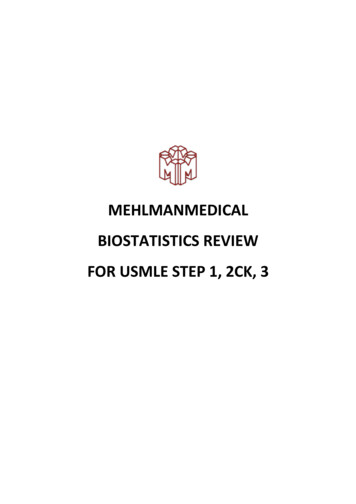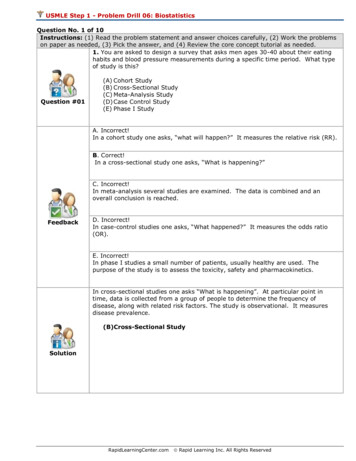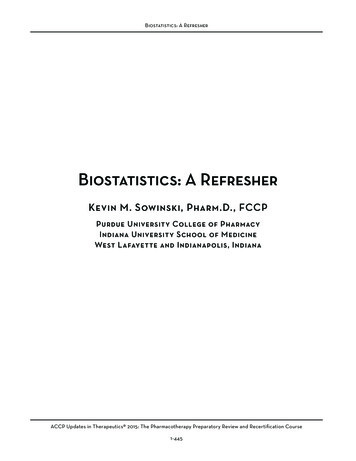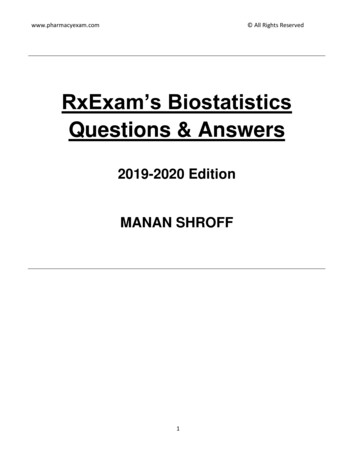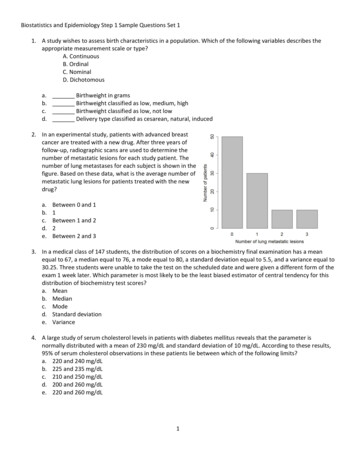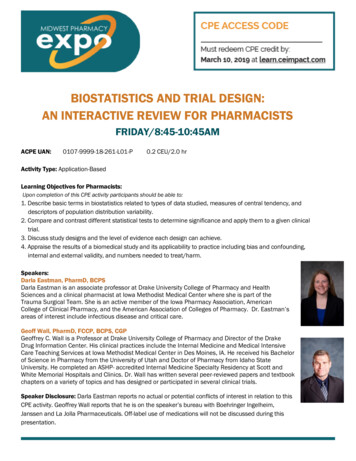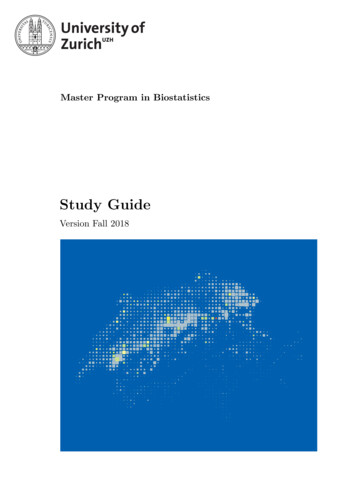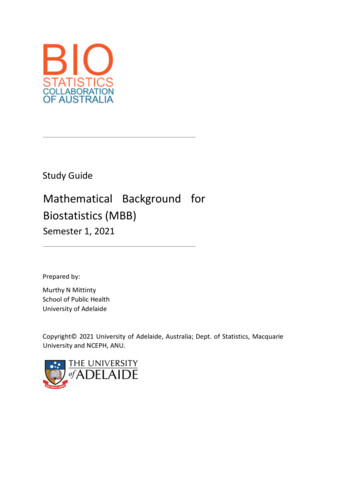![Clinical Biostatistics [CLB]](/img/6/study-guide-clb-2021.jpg)
Transcription
Study GuideClinical Biostatistics [CLB]Semester 1, 2021Prepared by:Annette Dobson, Mark Jones, Michael Coory, Peter Baker, Michael Waller and othersSchool of Public HealthUniversity of QueenslandCopyright School of Public Health, University of Queensland1
The following copyright information applies to all the readings included in this set of coursenotesCOMMONWEALTH OF AUSTRALIACopyright Regulations 1969WARNINGThis material has been reproduced andcommunicated to you by or on behalf ofUniversity of Queensland pursuant to Part VB ofthe Copyright Act 1968 (the Act).The material in this communication may besubject to copyright under the Act, Any furtherreproduction or communication of this material byyou may be the subject of copyright protectionunder the Act.Do not remove this notice.
Table of ContentsStudy Guide . 1Clinical Biostatistics [CLB] . 1Semester 1, 2021 . 11. Introduction . 4Workload requirements . 4Assumed knowledge . 42. Contacts. 43. Learning Objectives. 5Overall Objectives . 5Module 1: Statistical Process Control . 5Module 2: Clinical Agreement. 5Module 3: Diagnostic Tests, Systematic Reviews and Meta-Analysis . 6Module 4: Clinical Trials . 64. Method of Delivery & Communication . 7Recommended approaches to study . 7Method of communication with coordinator . 85. Unit Materials . 86. Software . 87. Textbooks . 98. References . 99. Assessment . 910. Timetable.1011. Complaints policy .1112. Summary of recent changes to materials and/or procedures.113
1. IntroductionThis unit or course comprises four topics that are important for practising biostatisticians, especiallythose working in clinical settings or, more generally, evidence-based health care. Each topic is coveredin a module designed to take 2 or 4 weeks to complete. Each module is more or less independent andcomprises a study guide, readings, and exercises. There are 3 assignments, one covering modules 1 and2, and the other two covering modules 3 and 4 respectively.Workload requirementsThe expected workload for this unit is 10-12 hours per week on average, consisting of guided readings,discussion posts, independent study and completion of assessment tasks.Assumed knowledgeThe following BCA units are recommended pre-requisites (*co-requisite).MBB: Mathematical Background for BiostatisticsEPI: EpidemiologyPDT: Probability and Distribution TheoryDES: Design of Randomised Controlled TrialsPSI: Principles of Statistical Inference*LMR: Linear Models2. ContactsThe coordinator and lecturer for this course is Michael Waller whose contact details are:School of Public Health, Public Health BuildingUniversity of QueenslandHerston Road, Herston QLD 4006E-mail: m.waller@uq.edu.auOffice phone: 07-3365-5116;If you have difficulties contacting the coordinator or lecturer, or would like to discuss your BCAprogram in general, please contact the BCA HQ.E-mail: bca@ctc.usyd.edu.au
3. Learning ObjectivesOverall Objectives1. Understand and apply Continuous Quality Improvement to medical studies and hospitaldata including detection of special and common causes of variation2. Explain and apply appropriate measures of agreement and consistency for both ratersand continuous measurements3. Calculate measures of the performance of diagnostic tests and interpret these via ROCcurves where appropriate4. Describe systematic reviews and undertake meta-analyses of various types of studies5. Understand advantages and disadvantages of cross-over designs in general and be ableto analyse 2x2 designs6. Explain the role of, and the relationships between, non-inferiority, efficacy andequivalence trials7. Calculate and report sample sizes for non-inferiority and equivalence trials8. Choose the appropriate graphical and/or statistical methods to answer clinical questions9. Effectively communicate the results of, and ideas behind statistical analyses performedto clinicians and statisticiansThe specific objectives of each module are as follows. On completion of the modules you should be ableto:Module 1: Statistical Process Control Understand the concepts of Continuous Quality Improvement and their usageDistinguish between Special Causes and Common Causes of variationDetect Special Causes of variation using a Shewhart control chartDetect Common Causes of variation using a CUSUM control chartDetect Common Causes of variation using a EWMA chartModule 2: Clinical Agreement Explain the concepts of validity and reliability of measurementsExplain the concepts of agreement and consistency between 2 or more measures how,for continuous measurements, these relate to simple correlation or regressionUse appropriate graphical and analytical methods to assess agreement between 2 ratersusing continuous, nominal or ordinal category measurement using Bland-Altmanmethods and kappa statistics5
Use appropriate intra-class correlations for agreement and consistency involving morethan 2 raters using continuous scale measurementsModule 3: Diagnostic Tests, Systematic Reviews and Meta-Analysis Calculate measures of performance of a diagnostic test: sensitivity, specificity, andlikelihood ratios.Translate the pre-test probability of disease for a particular patient into post-test,predictive values.Plot and interpret a ROC curve.Calculate the diagnostic odds ratio and explain its relationship to the ROC curve.Explain the rationale for doing systematic reviews, rather than narrative reviews.Describe the steps involved in undertaking a systematic review.Conduct a meta-analysis for various study types (including RCTs, observational studiesand diagnostic tests) and various outcome variables.Estimate and interpret heterogeneity across studies.Module 4: Clinical Trials Understand the advantages and disadvantages of using cross-over trialsBe able to prepare appropriate graphical displays of cross-over trial dataBe able to analyse 2x2 cross-over trials with a continuous response using both t-testsand analysis of varianceBe able to produce point estimates and confidence intervals for the parameters ofinterest in a 2x2 cross-over trial with a continuous responseUnderstand the underlying assumptions of these analyses and be able to performappropriate model checksBe able to analyse 2x2 cross-over trials with binary outcomesBe able to estimate the sample size required for a 2x2 cross-over trial.Understand the difference between equivalence and efficacy designsAppreciate the impact of such designs on analysis principles, e.g. intention-to-treat,especially in the presence of non-compliance.Be able to work out the sample size needed in equivalence designs andunderstand the difference with a similar calculation in a standard efficacy trialGet some exposure to non-inferiority studies, their role and link withequivalence trialsBe able to work out the sample size needed in non-inferiority studiesHave an idea on internal validity of equivalence/non-inferiority studies
4. Method of Delivery & CommunicationThe unit materials are available on the BCA eLearning site, along with the data sets for exercisesand assignments. Addtional materials such as copies of journal articles will be emailed to you. Ifyou wish the unit materials will be posted to you, with a copy of this guide.We would like to encourage the use of the discussion board facilities on the eLearning site, in orderto try and reduce the isolation of studying by distance. Firstly, you will see a ‘Student Introductions’forum on the discussion board. You can add your own information to this forum, if you wish, so thatothers in the course can contact you. For example:Jonathan Bloggsj.bloggs@ctc.edu.auph: 02-9999-9999NHMRC Clinical Trials Centre, SydneyJonathan is a trainee biostatistician at the Clinical Trials Centre. He is currently working with trials ofnew medications for diabetes and heart disease.This is entirely optional. If you would like to be part of the forum, but without your contact details, thatwill be fine as well.When you log in to the eLearning site, you will see under ‘Discussions’ various forum headings. We willinclude some general discussion points in each module to encourage discussion amongst the group, butwould like you to discuss matters and help each other as much as you can. Some students in the pasthave said they haven’t used the discussion board as much as they would have liked, as they didn’t wantto be seen to be colluding in the preparation of assignments. We encourage discussion about the coursematerial, and assignments, as long as worked answers are not given. Based on feedback from previousstudents we are no longer allocating any marks for participation in discussions.Outline solutions to the exercises in each module (except those to be submitted for assessment, asdescribed below) will be posted online at the midway point of the allocated time period for the module.This is intended to encourage you to attack the exercises independently (or via the eLearning site), andyet not make you wait too long to see the sketch solutions.Assignments will be sent, and marks posted using the eLearning assessment tool. In 2021, submissionwill be via TurnItIn for all assignments.Recommended approaches to studyStudents should work through each module systematically, following the module notes and any readingsreferred to, and working through the accompanying exercises. You will learn a lot more efficiently ifyou tackle the exercises systematically as you work through the notes. You are encouraged to post anycontent-related questions to eLearning, whether they relate directly to a given exercise, or are a requestfor clarification or further explanation of an area in the notes. You should also work through all of thecomputational examples in the notes for yourself on your own computer.7
Method of communication with coordinatorWe encourage you to maintain regular contact with the coordinator and get in touch with them if youhave any problems.Questions about administrative aspects or course content can be emailed to the coordinator, and whendoing so please use “(CLB):”, “BCA”, “Clinical Biostats” or similar in the Subject line of your email toassist in keeping track of our email messages. Coordinator/s will be available to answer questionsrelated to the module notes and practical exercises, and to address any other issues that requireclarification. However, please note that instructors are not necessarily available every day of the weekand you should expect that it may take a day or so to respond to questions (possibly longer overweekends and during breaks!).We strongly recommend that you post content-related questions to the Discussions tool in the CLB areaof BCA’s eLearning site. In 2021 we are using the Learning Management system hosted by theUniversity of Sydney. You may be familiar with the system from previous BCA units, and will receiveany specific instructions on using the eLearning site this semester from the BCA Coordinating Office.There is also a “Getting Started” document available on the Student Resources page of the BCA website.5. Unit MaterialsThe course consists of four modules. Each module has some brief notes to guide your reading and study.The modules usually begin with an overview pape
Study Guide . Clinical Biostatistics [CLB] Semester 1, 2021 . Prepared by: Annette Dobson, Mark Jones, Michael Coory , Peter Baker, Michael Waller and others School of Public Health University of Queensland . Copyright School of Public Health, University of Queensland

